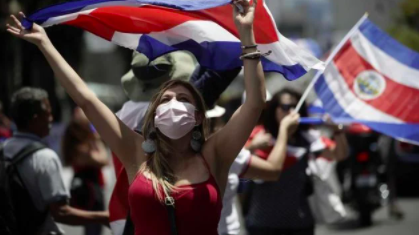
Good news for would-be jetsetters: Costa Rica is reopening its borders to all residents of the United States for tourism starting November 1. This is a development on the recent announcement that residents of Texas, Florida, and Georgia will be allowed to enter the country as tourists starting October 15. As always, inbound passengers will need health insurance and a negative PCR coronavirus test to enter.
Tourism Minister Gustavo Segura said this change will “allow us to reactivate tourism so that companies can work, at least, above the equilibrium point during the high season which runs from November 2020 to May 2021.”

How Things Will Be Different
Fortunately, none of Costa Rica’s COVID-19 cases from the past two months have come from foreign tourists, which has influenced Segura and other government officials to consider the economic benefits of reopening the country for tourism. However, the Costa Rica Tourism Board (ICT) says that entry and pandemic requirements will limit passenger volume to only 35-40% of its normal capacity, a striking change from previous years.
But it’s hard to deny that shutting out American tourists will eventually do a number on Costa Rica’s tourism industry, where Americans represent a whopping third of all the country’s tourists. What’s more Canadian and American tourists together comprise over half of the country’s total tourists, making this recent announcement a welcome breath of fresh air for Costa Rica’s sagging tourism industry.

Tourist Requirements for Entering Costa Rica
As previously mentioned, Costa Rica-bound tourists will have to have both valid travel insurance and a negative PCR coronavirus test obtained 72 hours or less before entering the country. However, there are a couple other things tourists will need to bring with them.
Before departing, you’ll also need to complete a “Health Pass” epidemiological form at https://salud.go.cr. You’ll also need to have spent 14 days in an authorized country before traveling. Furthermore, U.S. residents traveling before November 1 will have to present a valid driver’s license or state ID from an authorized state; after November 1, this rule will no longer apply.

How COVID-19 Is Still Affecting Costa Rica
According to data put together by The New York Times, Costa Rica is experiencing a rapid rise in cases with 77,289 total cases and 930 deaths. Fortunately, though, their healthcare system has not been saturated at any point, with only 36% of moderate-care beds and 62% of ICU beds occupied by coronavirus patients.
However, the U.S. Embassy released a message on October 9 notifying Americans of a number of protests that are currently cropping up in Costa Rica. These demonstrations are meant to protest ham-fisted government measures that were implemented in response to COVID-19, including suspension of social benefits, reduction of working hours, and tax increases.
Thankfully, most of the protests are peaceful, but Americans are still urged to exercise extreme caution and to stay away from large, boisterous crowds. Realistically, the greatest challenge these protests pose are blocked or partially-blocked roadways, which can dramatically increase travel time.
It’s also best to keep up with local media updates surrounding the demonstrations, so that you can take precautionary measures.
Even though the pandemic and entry requirements have changed significantly regarding entry to Costa Rica, the fact that all Americans will soon be able to visit the country is promising, to say the least. Hopefully, the rest of the world will follow suit as we continue to slowly return to the way things were before the beginning of the pandemic.
 Browse All
Browse All
